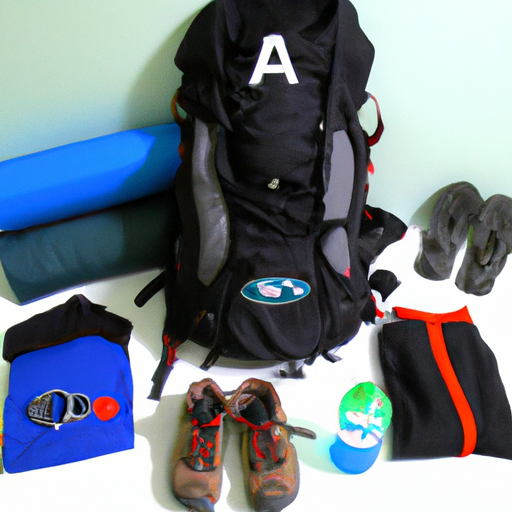What Size Backpack For Backpacking
Are you planning a backpacking adventure but unsure about what size backpack to take along? Look no further! In this article, we will guide you through the process of choosing the ideal backpack size for your backpacking needs. From considering the duration and type of trip to understanding your personal preferences and packing style, we’ve got you covered. By the end, you’ll feel confident in selecting the perfect backpack that will accompany you on your exciting journey. So, let’s get started and find the right match for you!
Considerations for Choosing the Right Size Backpack
When it comes to choosing the right size backpack for your backpacking adventures, there are a few important factors to consider. These considerations will ensure that you have a backpack that not only fits all your gear and supplies but also provides comfort and stability while you’re on the go. Let’s take a look at some of the key considerations for selecting the perfect backpack size.
Duration of the Trip
The duration of your trip plays a vital role in determining the size of the backpack you’ll need. If you’re planning a day hike or a short overnight trip, a smaller backpack will suffice. However, for longer adventures like weekend trips, multiday expeditions, or thru-hiking, you’ll need a larger backpack to accommodate all your gear and supplies.
Type of Backpacking
The type of backpacking you plan to do is another important consideration. If you’re a minimalist backpacker who likes to travel light, a smaller backpack will be more suitable. On the other hand, if you prefer to have all the comforts of home with you or if you’re planning a winter backpacking trip with additional gear, a larger backpack with more storage space is essential.
Personal Preferences
Your personal preferences also come into play when choosing a backpack size. Some backpackers prefer a compact and lightweight pack, while others prioritize having more storage space, even if it means a slightly larger and heavier backpack. Consider what is most important to you, whether it’s convenience, minimalism, or comfort, and choose a backpack size that aligns with your preferences.
Body Type and Fitness Level
Your body type and fitness level are crucial factors in determining the ideal backpack size. If you’re taller or have a longer torso, you’ll need a backpack with a longer torso length. Similarly, those with a smaller frame may require a smaller backpack to ensure a proper fit. Additionally, your fitness level may affect how much weight you can comfortably carry, so it’s important to choose a backpack size that aligns with your physical abilities.
Determining the Ideal Backpack Size
Now that we’ve discussed the considerations for choosing the right backpack size, let’s dive deeper into how to determine the ideal size for your specific needs.
Weight of the Gear and Supplies
One of the primary factors in determining backpack size is the weight of your gear and supplies. Heavier gear will require a larger backpack to accommodate it, whereas lighter gear can be accommodated in a smaller pack. Before selecting a backpack size, make a list of all the gear and supplies you plan to carry and estimate their weight to get a better idea of the size you’ll need.
Volume of the Gear and Supplies
In addition to weight, the volume of your gear and supplies is another important consideration. Some gear, such as sleeping bags or tents, may take up more space than others. Ensure that you choose a backpack size that provides enough volume to fit all your gear comfortably. Consider using compression sacks or pack organizers to maximize the available space inside your backpack.
Adding Space for Extra Items
It’s always a good idea to have some extra space in your backpack for unexpected items or additional gear you might need along the way. Whether it’s extra clothing layers, emergency supplies, or souvenirs you pick up during your trip, having some extra space in your backpack allows for flexibility and ensures that you’re prepared for any situation.
Considering Seasonal Gear
If you’re planning on backpacking during different seasons, you’ll need to take into account the gear specific to each season. Winter backpacking, for example, requires bulkier and heavier gear, such as insulated sleeping bags and extra layers, which will require a larger backpack. Consider the seasonal gear requirements and choose a backpack size that can accommodate all your gear comfortably.
Compactness and Organization
While having a larger backpack may provide more space for your gear, it’s important to prioritize compactness and organization. A well-designed backpack with multiple compartments and pockets can help you keep your gear organized and easily accessible. Look for backpacks that offer features like external pockets, internal dividers, and compression straps to ensure efficient and organized packing.
Backpack Size Ranges
Now that you have a better understanding of the factors that go into determining backpack size, let’s explore the different size ranges available and the types of trips they are suitable for.
Daypacks (10-25 liters)
Daypacks are the smallest backpacks, typically ranging from 10 to 25 liters in volume. These backpacks are perfect for short day hikes or trips where you only need to carry essential items like water, snacks, a jacket, and a first aid kit. They are lightweight, compact, and designed for maximum efficiency and mobility.
Weekend Packs (30-50 liters)
Weekend packs are slightly larger than daypacks, ranging from 30 to 50 liters in volume. These backpacks are ideal for overnight or weekend trips where you need to carry a bit more gear, such as a sleeping bag, cooking equipment, and additional clothing layers. They offer more space while still maintaining a reasonable size and weight.
Multiday Packs (50-75 liters)
Multiday packs are larger backpacks, typically ranging from 50 to 75 liters in volume. These backpacks are suitable for trips lasting two or more days, where you need to carry several days’ worth of food, a larger tent, extra clothing, and other essentials. They provide ample space for longer adventures and can accommodate a wide range of gear and supplies.
Expedition Packs (75+ liters)
Expedition packs are the largest backpacks, with a volume of 75 liters or more. These backpacks are designed for extended trips lasting a week or more and are meant to carry all your gear and supplies for extended periods. They are the go-to choice for thru-hiking, winter backpacking, or any other expedition where you’ll need a significant amount of gear and supplies.
Factors to Consider Based on Trip Duration
Now that we’ve covered the different backpack sizes available, let’s delve into the factors to consider for different trip durations.
Day Trips
For day trips, a small daypack in the range of 10 to 25 liters will be sufficient. Focus on carrying essentials like water, snacks, a first aid kit, a lightweight jacket, and any other gear specific to the activity you’re undertaking. Aim for a lightweight and compact backpack that allows for ease of movement and convenience.
Overnight Trips
For overnight trips, a weekend pack in the range of 30 to 50 liters is typically recommended. This size can accommodate a sleeping bag, sleeping pad, cooking equipment, extra clothing, and other necessary overnight gear. Ensure that the backpack provides enough space for your essentials while remaining comfortable to carry.
Weekend Trips
Weekend trips require a slightly larger backpack in the range of 30 to 50 liters. This size allows for more gear and supplies to be packed, including food, cooking utensils, a larger tent, additional clothing layers, and personal hygiene items. Consider the duration of your trip and the specific gear requirements when selecting a backpack size.
Multiday Trips
For multiday trips lasting two or more days, a larger backpack in the range of 50 to 75 liters is recommended. This size provides ample space for multiple days’ worth of clothing, food, cooking equipment, a larger tent, and any other gear you may need. Choose a backpack that offers organization features to keep your gear easily accessible during your trip.
Longer Expeditions
For longer expeditions, such as thru-hikes or trips lasting a week or more, an expedition pack with a volume of 75 liters or more is essential. These backpacks provide the space necessary to carry all your gear and supplies for an extended period. Consider the specific gear requirements of your expedition and choose a backpack size accordingly.
Adjustability and Fit
In addition to the size of the backpack, it’s important to ensure that it fits your body properly for optimum comfort and stability. Here are some key considerations for adjustability and fit.
Torso Length
The torso length of the backpack should match your own torso length for a comfortable fit. Most backpacks offer adjustable torso lengths to accommodate different body sizes. measure your torso length from the base of your neck to the top of your hip bone, and choose a backpack with a corresponding torso length range.
Hip Measurements
Hip measurements play a significant role in distributing the weight of the backpack properly. The hip belt should sit comfortably on your hips, with the majority of the weight resting on your hips rather than your shoulders. Measure your hip circumference and choose a backpack with a hip belt that matches your measurements.
Shoulder Width
Consider your shoulder width when choosing a backpack. The shoulder straps should be wide enough to distribute the weight evenly without digging into your shoulders. Look for backpacks with adjustable shoulder straps or those that offer different sizes to ensure a proper fit.
Use of Load Lifters
Load lifters are adjustable straps that attach to the upper portion of the backpack’s shoulder straps. They help to pull the pack closer to your body, improving weight distribution and stability. Make sure to adjust the load lifters properly to ensure a comfortable and secure fit.
Adjustable Waist Straps
Waist straps help to distribute the weight of the backpack onto your hips, relieving strain on your shoulders and back. Ensure that the waist strap is adjustable and can be tightened or loosened to fit your waist circumference comfortably.
Benefits of a Properly Sized Backpack
Choosing the right size backpack is not only about convenience but also about your overall comfort and well-being during your backpacking adventures. Here are some benefits of using a properly sized backpack.
Comfort and Stability
A backpack that fits properly and is the right size for your body provides increased comfort and stability while on the trail. It reduces the chances of chafing, rubbing, or discomfort caused by an ill-fitting backpack, allowing you to focus on enjoying your adventure.
Reduced Strain and Fatigue
An appropriately sized backpack distributes the weight evenly across your body, reducing strain on your shoulders, back, and hips. This distribution of weight minimizes fatigue and allows for a more enjoyable backpacking experience.
Improved Weight Distribution
A backpack that fits properly ensures that the weight is distributed optimally, with the majority resting on your hips. This balanced weight distribution makes it easier to maintain your balance and move freely on uneven terrain.
Efficient Organization and Accessibility
A backpack that is the right size allows for efficient organization and easy accessibility to your gear and supplies. Properly sized compartments, pockets, and internal dividers help you keep everything in its place, allowing for quick and easy access when needed.
Recommended Backpack Sizes for Various Activities
Now that we’ve covered the factors to consider and the benefits of a properly sized backpack, let’s explore the recommended backpack sizes for various activities.
Day Hikes
For day hikes, a small daypack in the range of 10 to 25 liters is recommended. This size is perfect for carrying essentials like water, snacks, a lightweight jacket, a first aid kit, and a camera. Choose a lightweight and compact backpack that allows for easy movement and ensures comfort throughout the hike.
Overnight Backpacking
For overnight backpacking trips, a weekend pack in the range of 30 to 50 liters is ideal. This size allows you to comfortably carry a sleeping bag, sleeping pad, cooking equipment, extra clothing layers, personal hygiene items, and other necessary overnight gear. Look for a backpack that offers organization features and easy access to your gear.
Weekend Backpacking
Weekend trips require a slightly larger backpack in the range of 30 to 50 liters. This size accommodates additional gear and supplies like food, cooking utensils, a larger tent, extra clothing layers, and personal hygiene items. Choose a backpack that strikes a balance between size and weight without compromising comfort.
Multiday Backpacking
For multiday trips lasting two or more days, a backpack in the range of 50 to 75 liters is recommended. This size provides ample space for multiple days’ worth of clothing, food, cooking equipment, a larger tent, and any other gear you may need. Look for a backpack that offers organization features and a comfortable suspension system.
Thru-Hiking
Thru-hiking, which involves long-distance backpacking over several weeks or months, requires a larger backpack with a volume of 75 liters or more. This size allows you to carry all your gear, supplies, and food for extended periods. Choose a backpack specifically designed for thru-hiking, with features like a lightweight yet durable construction, comfortable suspension system, and efficient organization options.
Winter Backpacking
Winter backpacking requires additional gear and clothing layers, making a larger backpack in the range of 50 to 75 liters necessary. This size ensures that you have enough space for insulated sleeping bags, extra clothing, cooking equipment suitable for cold weather, and other winter-specific gear. Look for a backpack with external attachment points for carrying snowshoes or ice axes.
Tips for Properly Packing a Backpack
Once you’ve selected the right backpack size and have all your gear and supplies ready, it’s important to pack your backpack properly to ensure maximum comfort and efficiency on the trail. Here are some tips to help you pack your backpack effectively.
Utilize Compression Straps and Pack Organizers
Take advantage of compression straps and pack organizers to maximize the available space inside your backpack. Compression straps help to secure your gear and prevent unnecessary movement, while pack organizers, such as stuff sacks or packing cubes, aid in keeping your gear organized and compact.
Pack Heavier Items Close to your Back
When loading your pack, place heavier items closer to your back to maintain stability and balance. This placement helps to distribute the weight more evenly and prevents strain on your shoulders. Position items like a stove, cooking equipment, or a water bladder near the center of your pack.
Separate Essential and Non-Essential Gear
Differentiate between essential and non-essential gear when packing your backpack. Essential items like a map, compass, water, and food should be easily accessible in case of emergencies or quick access needs. Non-essential items can be packed deeper in the backpack, as they won’t be needed as frequently.
Distribute Load Evenly
Distribute the weight of your gear and supplies evenly throughout your pack. This distribution helps to maintain balance and prevent strain on specific areas of your body. Avoid overloading one side of the pack, as it can lead to discomfort and imbalance on the trail.
Accessible Pockets and Safety Equipment
Ensure that your backpack has easily accessible pockets or compartments for safety equipment like a first aid kit, headlamp, or emergency whistle. These items should be readily available in case of emergencies or unexpected situations on the trail. Having quick access to essential safety equipment can make a significant difference in potentially critical situations.
Final Thoughts
Choosing the right size backpack is essential for a comfortable and enjoyable backpacking experience. Consider factors such as the duration of your trip, the type of backpacking you plan to do, your personal preferences, and your body type and fitness level. Take into account the weight and volume of your gear and supplies, as well as the need for extra space and seasonal gear. Remember to prioritize comfort and stability by ensuring a proper fit and adjusting the backpack’s torso length, hip measurements, shoulder width, load lifters, and waist straps. By selecting the right backpack size and following proper packing techniques, you’ll be well-prepared to embark on your backpacking adventures with ease and confidence.




